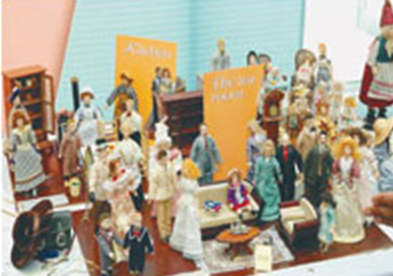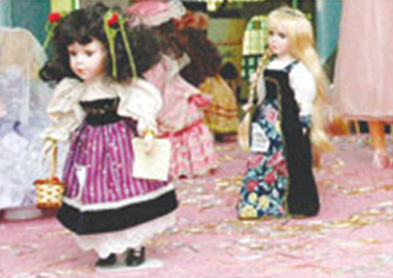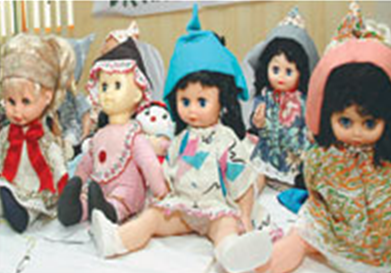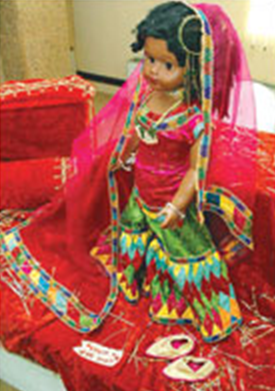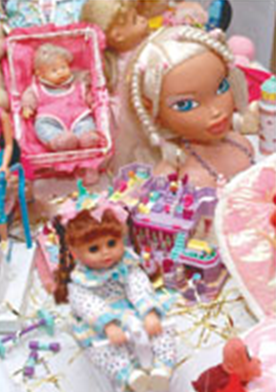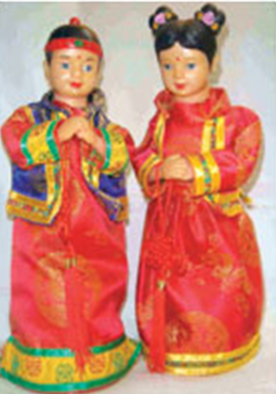Doll craft
This is a collection of articles archived for the excellence of their content. Readers will be able to edit existing articles and post new articles directly |
Doll craft
Doll craft — a privately pursued passion
By Salwat Ali
Photography by Fahim Siddiqi
It was dolls galore at the recent Lifestyle Exhibition in the Expo Centre. The organisers’ invitation to the public to enter their doll(s) for display and award selection met with an overwhelming response. An unexpected turnout of approximately 1500 dolls had to be accommodated on two floors of the centre as best as possible. While a profusion of Barbie fashion dolls and Baby play dolls dominated the show it was the serious Collector dolls, antique varieties, Porcelain specimens and innovative Hand Crafted dolls that piqued adult viewer interest. Perhaps the first collective display of public owned dolls in this lavish outpouring, brought a privately pursued passion out of the closet. It identified this ‘hobby’ as an independent genre with its own circle of doll artists, manufacturers, connoisseurs and collectors.
An intelligent display enhances viewership but unfortunately a profusion of visitors and dolls made for a crowded and cluttered atmosphere at the display centre. Prolonged air conditioning outages also marred the viewing experience considerably. For the sake of clarity, in future showings it would also be wiser to allot a separate arena to the Barbie and baby doll variety. With an emphasis on fashion and its accessories this category has a large audience of young girls who patronise the trendy dolls as coveted playthings and a larger and exclusive space would facilitate a more comprehensive and orderly display.
The finer points of the other dolls related to exquisite workmanship, novelty, exotic appeal, sentimental value and cultural ambience. In the antique category half a century old dolls were put up for display with owners on hand with tales of their origin. A set of hand painted chalk stick dolls were innovative as were the fabric rag dolls and golliwogs. Elaborate coiffeurs and elegant Victorian finery of the European dolls impacted the eye instantly. Exquisitely crafted out of porcelain they were attractive to look at and were relatively well displayed in vantage positions. Similarly, the collector variety was high on aesthetics with tremendous attention to detail and craftsmanship.
A large number of foreign dolls in regional costumes were representative of their specific countries like a dancer from Thailand, an almost three foot tall tea picker from Darjeeling, Red Indian leather dolls, Japanese kimono clad dolls. An avid collector had an entire series of dolls that were placed together with accessories including a hand made tea set and furniture like sofa set, arm chair and rugs, and the display enacted scenes of Victorian life. Finely tailored, festive regional costumes and bridal wear spoke of Pakistani culture but unlike the other international dolls these costumes were fitted onto commercial imported dolls not made in Pakistan. It is a pity that there were next to no dolls of Pakistani origin produced for display in this exhibition.
Is doll craft a neglected genre in Pakistan? Have we not progressed beyond the primitive hand painted, stuffed fabric dolls so commonly available in cottage industry outlets a few decades ago? Stitched by hand they used to be dressed in regional costumes and catered to the tourist market. Where are they now? This bumper crop of dolls at the Expo Centre indicates that the urge to collect or play with dolls is very much there but tastes have changed and a more discerning public is opting for smarter, more attractive options. It also manifests that doll craft in Pakistan has not moved with the times and is still languishing in the backwaters.
Unless we begin producing contemporary models our products will continue to be overshadowed by the international varieties. One wonders why our designer and artist community is not toying with the idea of rescuing or reinventing the Pakistani doll. It is an art form with sculptural overtones and designer attributes and the possibilities of new models are endless.
A small collection of Hunza dolls, belonging to Masroor Khan, displayed at the same venue answer to this need to some extent. They were manufactured in a toy village called Thatta Kehdona in Ghulamka Dhiroka in district Okara, Punjab. Started as a self help project by two German volunteers Dr Norbert Pintsch and Dr Senta Siller to generate cash income for farming families there, this NGO like co-operative has had 36 volunteer visitors from western countries coming in to instruct and coach the locals in doll craft.
It is supported by many countries around the globe and in Pakistan the project also enjoys cooperation of prestigious educational institutions – Bahauddin Zakariya University, Multan, Indus Valley School for Art and Architecture, Karachi, School of Visual Art, Lahore, Arid Agriculture University, Rawalpindi
While Thatta Kedona is a noble effort worth emulating by others it still concentrates largely around the production of a folk variety of dolls by semi skilled labour. Doll craft is a bustling industry the world over, with production comprising the very traditional to the most contemporary. The Alexander Doll company — the last major manufacturer of hand crafted dolls in the United states — makes 400 types of dolls a year and more than 3000 dolls a day.
These range from classic characters from, ‘The Wizard of Oz’ and Cinderella, to Coca Cola dolls, Betty Boop dolls, Huggums soft bodied baby dolls and ‘Cissy’ haute couture dolls with fake fur coats, strapless gowns, velvet skirts and silk underwear, ranging in price from $25 to $400. Inside the company there is a doll hospital also to repair dolls that have been loved too much and as many as 80 dolls a week are ‘treated’ for rerooting of hair, painting of lips, fixing clothes etc. The company sells almost a 100 Madame Alexander dolls a week but children are not its largest market; the most ardent buyers are the adult collectors.
The Madame Alexander Doll Club currently has more than 10,000 members, a Website and annual conventions. Many adult buyers are doctors, lawyers and professional women who want to have something beautiful and luxurious. The doll is also a shrewd investment. A Deborah doll brought in 1951 for $69.95 is now worth $15,000. But much more than all this is the fact that Madame Alexander is cited as having given America doll making status in the world.
Dolls galore at the Expo Centre where an unexpectedly large turnout of exhibitors showcased 1500 dolls. These included — collector dolls, Barbie dolls, handpainted chalkstick dolls, rag dolls, Red Indian leather dolls, Japanese kimono-clad dolls, golliwogs and European dolls in all their Victorian finery.
